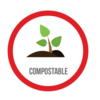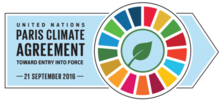Submitted by Student Associate Jessica Oliver
As cities around the world move towards a more sustainable way of life, it’s important to have an understanding of the different terminology that is used and its implications on environmental issues. Each citizen can make an impact on their community and their environment, by simply being more informed on the issues. We have access to so much information, but it can be overwhelming. This resource breaks down a list of environmental words and phrases you may hear in the news or read in an article. Under each word is a brief definition along with websites that have more information.
Biodegradable
Biodegradable products are made up of materials that break down naturally without causing harm to the environment. Fruits and vegetables are biodegradable as well as some paper and other items. Recently companies have begun to make biodegradable products like plates, cups, and utensils. However, these products can be misleading because they may only be able to break down in an industrial biodegradable setting. Industrial biodegradable settings are usually more controlled than natural settings. If you'd like more information on what material is biodegradable and which is not, the World Wildlife Foundation's article has a lot of information.
Carbon Footprint

A carbon footprint is a calculation of the amount of carbon dioxide and other carbon compounds a person or a business puts into the environment through their lifestyle. Things such as mode of transportation (car, public transportation, walking, etc), consumption of meat or local produce, among other things can impact an individual's carbon footprint. If you would like to learn more about carbon footprints or take the survey to determine your personal carbon footprint visit the Carbon Footprint website.
Carbon Neutral
Carbon neutral is when there is no net release of carbon. For example, if a company releases a certain amount of carbon into the environment and then takes actions to take that same amount of carbon out of the environment, they are carbon neutral. This is often done by planting trees or donating money to organizations that work to reduce carbon emissions. This website has a lot of information regarding going and being carbon neutral.
Compostable

Items that can break down into small pieces within 90 days and don’t release toxic residue are considered compostable. Things like newspaper, eggshells, coffee grounds, fruits, veggies, etc can all be composted. They break down into nutrient-rich soil and can be used to help plants grow. Composting can happen on individual, communal, and industrial levels. Composting helps reduce the amount of food waste that gets sent to the landfill. Visit World Centric to learn more about composting.
Deforestation
Deforestation happens when forests or large groups of trees are cut down and the land is converted to non-forest use such as farming. This can also be caused by natural actions like forest fires or overgrazing. Deforestation often damages the quality of the land and removes habitats for animals. This Conservation International article has facts about deforestation in the U.S. and other countries.
E-Waste
E-waste can be thought of as electronic waste. Computers, cell phones, chargers, tablets, and TVs are considered to be e-waste. Appliances and electronics can be recycled through e-waste recycling programs or given to companies for parts but are often sent to the landfill. The EPA works to encourage citizens and other countries to dispose of their e-waste properly.
Earth Overshoot Day
Earth Overshoot Day is a day of the year when our demands for resources in a given year exceeds what the earth can produce in a year. Humanity as a whole has an earth overshoot and individual can take a survey to determine their personal earth overshoot day.
Energy Efficient
The term energy efficient is used when a task can be performed without the unnecessary waste of energy. An example of this is revolving doors versus regular doors. Revolving doors reduce the amount of energy that may escape when someone opens the doors. Purchasing energy efficient products can be more expensive upfront but usually pays off in the amount of energy saved.
EPA

The EPA is short for Environmental Protection Agency and is a subset of the United States government. The EPA was founded in 1970 with the mission to protect human health and the environment. A few of its goals include review chemicals in products to determine their safety, ensure Americans have clean air, water, and land, and that laws and regulations are fairly enforced. The EPA also studies environmental issues in order to better understand and potentially solve them.
Greenwashing
Greenwashing is when a company tries to make their product seem more environmentally friendly. This is a marketing practice used to attract eco-conscious consumers. A company may be accused of greenwashing if it spends more time and money advertising itself as environmentally friend than it actually spends being environmentally friendly. For example, a product labeled as “all-natural” may still have harmful chemicals that occur naturally. Companies may not provide proof of their claim or be extremely vague.
Paris Agreement

The Paris Agreement is an agreement signed in 2016 by 196 countries with the goal of each country reducing carbon emissions. This agreement stands apart from previous agreements because it allows countries to determine how they will reduce carbon emissions, how much they want to reduce, and by when. Visit the United Nation's Sustainable Development website to learn more about the Paris Agreement.
Recycle

Recycling is the process of converting waste into new materials. Paper, plastic, glass, some metals, and more can all be recycled. Recycling centers don’t always accept all recyclable materials because some materials are more difficult to recycle than others. When looking at a product made from plastic you may see a triangle with a number in the middle, the number indicates what type of plastic it is. One downside to using plastic is it can only be recycled a limited number of times before its quality is too low to use again, then it ends up in a landfill. Glass, on the other hand, can be recycled almost endlessly without serious loss of quality, however, it is more difficult to recycle. Read more about the details and benefits of recycling on the EPA's website.
Renewable Energy
Energy forms like solar, wind, and water are all forms of renewable energy. This type of energy creates nearly no pollution, does not deplete natural resources, and does not run out. Cities all over the world are slowly switching their energy sources from fossil fuels to renewable sources because of the impact these energy sources can have on our environment and our health. The National Renewable Energy Laboratory provides more information of renewable energy here.